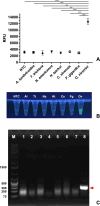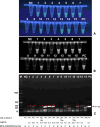Ov-RPA-CRISPR/Cas12a assay for the detection of Opisthorchis viverrini infection in field-collected human feces
- PMID: 38383404
- PMCID: PMC10882828
- DOI: 10.1186/s13071-024-06134-7
Ov-RPA-CRISPR/Cas12a assay for the detection of Opisthorchis viverrini infection in field-collected human feces
Abstract
Background: Opisthorchis viverrini infection is traditionally diagnosed using the Kato-Katz method and formalin ethyl-acetate concentration technique. However, the limited sensitivity and specificity of these techniques have prompted the exploration of various molecular approaches, such as conventional polymerase chain reaction (PCR) and real-time PCR, to detect O. viverrini infection. Recently, a novel technique known as recombinase polymerase amplification (RPA)-clustered regularly interspaced short palindromic repeats (CRISPR)/CRISPR-associated protein (Cas) (RPA-CRISPR/Cas) assay was developed as a point-of-care tool for the detection of various pathogens, including viruses and bacteria such as severe acute respiratory syndrome coronavirus 2 and Mycobacterium tuberculosis. This technology has demonstrated high sensitivity and specificity. Therefore, we developed and used the RPA-CRISPR/Cas assay to detect O. viverrini infection in field-collected human feces.
Methods: To detect O. viverrini infection in fecal samples, we developed a CRISPR/Cas12a (RNA-guided endonuclease) system combined with RPA (Ov-RPA-CRISPR/Cas12a). Several fecal samples, both helminth-positive and helminth-negative, were used for the development and optimization of amplification conditions, CRISPR/Cas detection conditions, detection limits, and specificity of the RPA-CRISPR/Cas12a assay for detecting O. viverrini infection. The detection results were determined using a real-time PCR system based on fluorescence values. Additionally, as the reporter was labeled with fluorescein, the detection results were visually inspected using an ultraviolet (UV) transilluminator. A receiver operating characteristic curve (ROC) was used to determine the optimal cutoff value for fluorescence detection. The diagnostic performance, including sensitivity and specificity, of the Ov-RPA-CRISPR/Cas12a assay was evaluated on the basis of comparison with standard methods.
Results: The Ov-RPA-CRISPR/Cas12a assay exhibited high specificity for detecting O. viverrini DNA. On the basis of the detection limit, the assay could detect O. viverrini DNA at concentrations as low as 10-1 ng using the real-time PCR system. However, in this method, visual inspection under UV light required a minimum concentration of 1 ng. To validate the Ov-RPA-CRISPR/Cas12a assay, 121 field-collected fecal samples were analyzed. Microscopic examination revealed that 29 samples were positive for O. viverrini-like eggs. Of these, 18 were confirmed as true positives on the basis of the Ov-RPA-CRISPR/Cas12a assay and microscopic examination, whereas 11 samples were determined as positive solely via microscopic examination, indicating the possibility of other minute intestinal fluke infections.
Conclusions: The Ov-RPA-CRISPR/Cas12a assay developed in this study can successfully detect O. viverrini infection in field-collected feces. Due to the high specificity of the assay reported in this study, it can be used as an alternative approach to confirm O. viverrini infection, marking an initial step in the development of point-of-care diagnosis.
Keywords: Clustered regularly interspaced short palindromic repeats (CRISPR)/CRISPR-associated protein 12a (CRISPR/Cas12a); Diagnostic method; Fecal sample; Opisthorchiasis; Opisthorchis viverrini; Recombinase polymerase amplification.
© 2024. The Author(s).
Conflict of interest statement
The authors declare that they have no competing interests.
Figures





Similar articles
-
Development of a Copro-RPA-CRISPR/Cas12a assay to detect Echinococcus granulosus nucleic acids isolated from canine feces using NaOH-based DNA extraction method.PLoS Negl Trop Dis. 2024 Dec 12;18(12):e0012753. doi: 10.1371/journal.pntd.0012753. eCollection 2024 Dec. PLoS Negl Trop Dis. 2024. PMID: 39666765 Free PMC article.
-
Advances in the Diagnosis of Human Opisthorchiasis: Development of Opisthorchis viverrini Antigen Detection in Urine.PLoS Negl Trop Dis. 2015 Oct 20;9(10):e0004157. doi: 10.1371/journal.pntd.0004157. eCollection 2015. PLoS Negl Trop Dis. 2015. PMID: 26485024 Free PMC article.
-
Retrotransposon OV-RTE-1 from the carcinogenic liver fluke Opisthorchis viverrini: potential target for DNA-based diagnosis.Infect Genet Evol. 2014 Jan;21:443-51. doi: 10.1016/j.meegid.2013.12.015. Epub 2014 Jan 3. Infect Genet Evol. 2014. PMID: 24394447 Free PMC article.
-
Immunology and molecular biology of Opisthorchis viverrini infection.Acta Trop. 2003 Nov;88(3):195-207. doi: 10.1016/j.actatropica.2003.02.002. Acta Trop. 2003. PMID: 14611874 Review.
-
Detection of Porcine Circovirus (PCV) Using CRISPR-Cas12a/13a Coupled with Isothermal Amplification.Viruses. 2024 Sep 30;16(10):1548. doi: 10.3390/v16101548. Viruses. 2024. PMID: 39459882 Free PMC article. Review.
Cited by
-
An RPA-Based CRISPR/Cas12a Assay in Combination with a Lateral Flow Assay for the Rapid Detection of Shigella flexneri in Food Samples.Foods. 2024 Oct 9;13(19):3200. doi: 10.3390/foods13193200. Foods. 2024. PMID: 39410234 Free PMC article.
-
CRISPR/Cas12a-Based Biosensing: Advances in Mechanisms and Applications for Nucleic Acid Detection.Biosensors (Basel). 2025 Jun 4;15(6):360. doi: 10.3390/bios15060360. Biosensors (Basel). 2025. PMID: 40558442 Free PMC article. Review.
-
CRISPR/Cas genome editing, functional genomics, and diagnostics for parasitic helminths.Int J Parasitol. 2025 May 19:S0020-7519(25)00092-X. doi: 10.1016/j.ijpara.2025.05.001. Online ahead of print. Int J Parasitol. 2025. PMID: 40348052 Review.
-
Development of a rapid on-site detection method for largemouth bass virus based on RPA-CRISPR/Cas12a system.Front Microbiol. 2025 May 21;16:1599006. doi: 10.3389/fmicb.2025.1599006. eCollection 2025. Front Microbiol. 2025. PMID: 40469727 Free PMC article.
-
Research progress on the application of RPA-CRISPR/Cas12a in the rapid visual detection of pathogenic microorganisms.Front Cell Infect Microbiol. 2025 Jul 30;15:1640938. doi: 10.3389/fcimb.2025.1640938. eCollection 2025. Front Cell Infect Microbiol. 2025. PMID: 40809520 Free PMC article. Review.
References
-
- International Agency for Research on Cancer A review of human carcinogens: biological agents. IARC Monogr Eval Carcinog Risks Hum. 2012;100:341–370.
-
- Sripa B, Kaewkes S, Intapan PM, Maleewong W, Brindley PJ. Chapter 11. Food-borne trematodiases in Southeast Asia: epidemiology, pathology, clinical manifestation and control. Zhou X-N, Bergquist R, Olveda R, Utzinger J, editors. Adv Parasitol. 2010;72:p. 305–50. - PubMed
-
- Kopolrat KY, Singthong S, Khuntikeo N, Loilome W, Worasith C, Homwong C, et al. Performance of Mini Parasep® SF stool concentrator kit, Kato-Katz, and formalin-ethyl acetate concentration methods for diagnosis of opisthorchiasis in Northeast Thailand. Parasit Vectors. 2022;15:234. doi: 10.1186/s13071-022-05338-z. - DOI - PMC - PubMed
MeSH terms
Substances
Grants and funding
LinkOut - more resources
Full Text Sources

